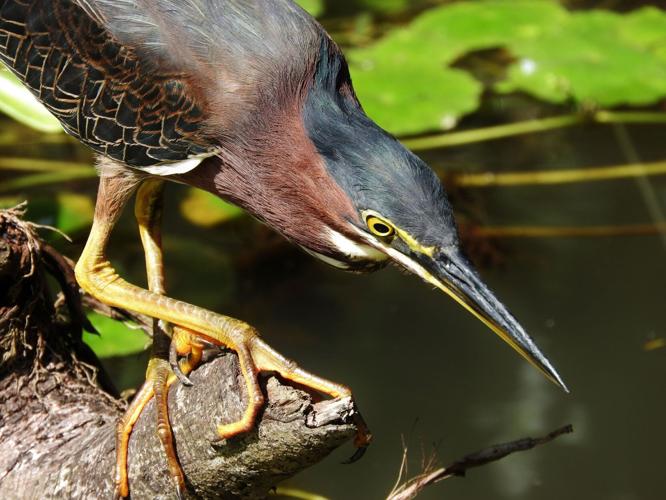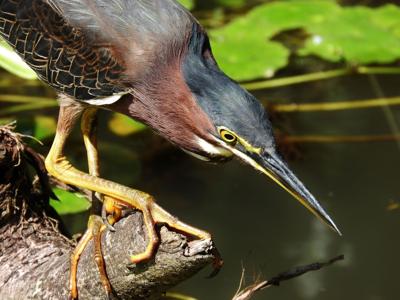Birdsong emanated from every alder thicket and treetop as we floated down the Namekagon River. The natural habitat here, protected by the National Park Service as part of the St. Croix National Scenic Riverway, is teeming with life. Though we could admire the colorful flowers and damselflies, the little singers stayed hidden in the brush. In between songs they were probably hunting caterpillars to feed to their chicks.
But the bigger birds were far more visible. The skew of a startled green heron alerted us to their presence. We looked up in time to watch them land in a tree with their bright, orange legs. With our eyes in the air, we spotted an osprey disappearing around the river bend. A kingfisher made a single rattling cry as he swooped from branch to branch in his powder-blue tux. And as I looked up from photographing damselflies, an eagle materialized in a distant white pine. No caterpillars gleaned from dense leaves would satisfy these birds. They were looking for fish.
I pretty much stopped fishing after my dad stopped untangling my line and tying my hook. The few times I’ve tried as an adult, I’ve come up empty-handed. So I have the utmost respect for osprey, a bird who catches at least one fish for every four dives. How do they do it? Osprey, eagles, kingfishers and green herons have adaptations that make them excellent anglers.
First, all these birds have excellent eyesight, and a third set of clear eyelids, called nictitating membranes, that close like goggles when they dive. But water is weird, and visual acuity isn’t enough. Have you ever looked at a drinking straw through a clear glass of water? To our eyes, the straw seems to kick off to one side at the surface, because the denser water bends light differently than air. For humans, this refraction makes it difficult to accurately reach for something below the water surface. Somehow, these birds can compensate for refraction and aim correctly.
For kingfishers, scientists have figured out a special mechanism. Two focal points in their eyes allow kingfishers to adjust for the change in refraction between air and water as they dive after a fish. The position of these two foveae gives kingfishers monocular vision in the air (each eye is used separately) and binocular vision underwater (which allows them to judge distance).
To hunt, ospreys, eagles and kingfishers may perch on an overhanging branch, or hover directly above the water. Herons prefer to do their stalk-and-stab routine while standing on the ground.
Seeing below the surface doesn’t mean any of these birds want to dive super deep. They all hunt in shallow water — although shallow to an osprey is 3 feet, while shallow to a heron is 3 inches. All of their relatively short, broad tails aid them in soaring, while not getting in the way when they dive.
Eagles and ospreys, being raptors, have strong talons. Additionally, spines on their toes help them grip fish. Powerful wings allow them to lift off even when carrying several pounds of dinner.
The abundance of white feathers on the underside of an osprey makes it easy for us to distinguish them from eagles — and makes it harder for a fish to notice them against the bright sky. Once an osprey spots a fish, they tuck in their wings and dive headfirst toward the water, switching to feet first as they close in. Osprey’s longs legs mean that they don’t always go under when plunging for a fish, but if they do, their nostrils close and oil on their feathers keep them from getting waterlogged.

As the osprey grabs hold, their outer toes reverse. This allows the osprey to grip a fish facing forward, aerodynamically, with an equal number of toes on each side of the body. Most of the fish they catch are 6 to 13 inches in length, and weigh around half a pound. Their long wings beat powerfully to lift both bird and prey from the water. And then, they use their hooked beak, a trait they share with eagles and other raptors, to tear the fish into bite size pieces. Of all the raptors, ospreys are the only ones who eat almost 100% live fish.
While not raptors, kingfishers also plunge in for their prey. Unlike ospreys, their conical beak hits the water first, and pushes it aside with minimal impact or splash. Instead of tearing fish into bite-sized pieces, the kingfisher carries the perch to a perch and whacks them dead, then swallows them whole. Kingfishers, who are 13 inches long at most, have been known to eat fish up to 7 inches long. The trick? They leave part of the fish hanging out of their beak until stomach juices digest enough of the fish that it can slide in all the way.
Green herons also employ a dagger-like beak to catch or spear fish, usually while stalking through the shallows. Green herons will place a little bit of bait — insects, feathers, sticks or bread crusts — on the surface and then eat small fish who are lured in. This type of tool use is rare among birds.
As we rounded yet another bend in the river, a human angler came into view. He was standing in a riffle with his favorite tool — a fly rod — looking happy. Whether you wear feathers or khaki, the Namekagon River is a great place to catch fish.
Emily’s award-winning second book, Natural Connections: Dreaming of an Elfin Skimmer, is available to purchase at www.cablemuseum.org/books and at your local independent bookstore, too.





(0) comments
Welcome to the discussion.
Log In
Thank you for taking part in our commenting section. We want this platform to be a safe and inclusive community where you can freely share ideas and opinions. Comments that are racist, hateful, sexist or attack others won’t be allowed. Just keep it clean. Do these things or you could be banned:
• Don’t name-call and attack other commenters. If you’d be in hot water for saying it in public, then don’t say it here.
• Don’t spam us.
• Don’t attack our journalists.
Let’s make this a platform that is educational, enjoyable and insightful.
Email questions to [email protected].